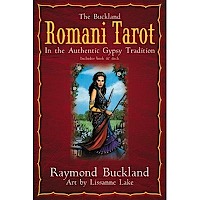By Sheri Harshberger
There are hundreds, if not thousands of Tarot decks available to readers today, but of those, only a handful really step out and set a unique paradigm rather than following those established before them. One of these ground breaking decks is the Buckland Romani Tarot, created by metaphysical icon Raymond Buckland and illustrated by Lissanne Lake.
As an out of print (OOP) deck, it is one of the most highly sought after. It is infrequently available as the people who own it do not part with it easily. It is not hard to see why! Imagine my absolute joy when I heard that it was going to be published again! The cards of the new version will be identical to the original deck, with the only change to the set being a new introduction in the book.
The Buckland Romani Tarot follows the traditional, 78-card deck structure with 22 Majors and 56 Minors. In the Majors, The Fool is numbered 0 but considered unnumbered. Strength is 8 and Justice is 11. The High Priestess is represented by the matriarch of the tribe, and Justice is represented by the Romani court. The pips are all scenic. The Courts include a King, Queen, Knight and Page. Interestingly, all the Pages are male except for the Page of Cups. I love the Courts in this deck. Each member of the Courts is an individual, rather than a copy of the others with different colors substituted. This deck is one of the few that doesn't just reinterpret Tarot via the substitution of imagery - it redefines Tarot within the context of the Romani gypsy culture. Cards such as The Magician and Justice reflect the mystic heritage of the Romani gypsy culture and the strong society that exists within it.
The card stock is sturdy. The cards are approximately the same size as a traditional deck, but seem larger when viewing the images on each card as they have no borders. The Majors have only a number to identify each card, and the Minors have titles at the bottom of each card - located where they will not impact the illustrations. Mr. Buckland has done this for a very specific purpose - in the companion book, he discusses his preferred method of reading the cards using a method that is primarily intuitive - you see what you see in the card - the name of the card is immaterial at that point. This approach speaks volumes to me, and is one of the reasons I cut the borders, including titles and keywords, off my Thoth decks.
In fitting with the Romani context, the traditional Tarot suits of Cups, Pentacles, Swords and Wands have been replaced by Koros, Bolers (Wheels), Chivs (Knives), and Koshes (Staves), respectively. The Koros are represented by either a teacup (with or without saucer) or a water container (known as a water jack). Koshes are represented by either a stave or horse whip. According to the companion book, the backs of the cards feature a representation of the Romani flag. A 16-spoke wagon wheel is centered on a background of blue and green quadrants. The blue represents the sky above and the green represents the earth below. There is no top or bottom apparent when looking at the backs of the cards, so the deck can be used for reversals. In fact, Mr. Buckland includes reversed meanings in the companion book.
To say the artwork in this deck is stunning is a gross understatement. The colors are vibrant and the detail in each card is almost photographic. The people are beautiful and seem amazingly lifelike. Certain cards almost seem 3-dimensional. Viewing each card is like going through a Romani photo album (if there were such a thing), each card a snapshot in the context of these gypsies' bygone lifestyle of traveling in ornate, horse drawn English vardos under the open sky. In many of the cards, the people in them are looking at us from within the card and inviting us into the scene currently taking place there. The cards are very readable.
Reading the 240-page companion book, The Buckland Romani Tarot: The Gypsy Book of Wisdom, is like chatting with Mr. Buckland personally. He discusses how he came to create the deck, the relationship between the Tarot and the Romani, and the integration of Tarot with other systems such as Qabbalah and the Tree of Life. He has suggestions for reading intuitively - such as laying out the cards face down and turning them over as they are read, and noting what comes before the card is turned over. What is really interesting is he singles out particular Rider Waite Smith cards as examples and identifies details within the cards that I had never noticed before - such as the tiny sailing ship in the Death card, the skull image in the side of one of the cups in the 7 of Cups, and the two different shoes worn by the young man in the 7 of Wands (that one I had noticed before). The book makes it possible for everyone who owns this deck to receive a one-on-one master class with a master.
The book includes traditional upright and reversed meanings for each card, as well as a comprehensive Romani-specific meaning, which includes details and insight into the scene each card depicts. This is invaluable for those of us newly exposed to the Romani culture.
This is a great set if you are learning Tarot, wanting to expand your Tarot knowledge outside the Rider Waite Smith or Marseilles traditions, or just want an introduction to the Romani culture.
